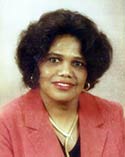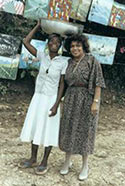Dr. Edith Irby Jones
Born in 1927 in rural Arkansas, Dr. Edith Irby Jones spent her first eight years living on a tenant farm with her brothers, sister, and parents. After her father died, her family eventually moved to Hot Springs, Arkansas. With the encouragement from her high school teacher, Margaret Long Martin, Dr. Jones attended Knoxville College in Tennessee. A strong student who had performed exceptionally well on her exams, she was accepted at many medical schools.
In 1948, Edith Irby Jones became the first African-American student to enter the Medical School of the University of Arkansas in Little Rock, Arkansas. In a class of ninety-one, she was the only African American and one of only three women. She recalls that many of her classmates were returning veterans who treated her with respect, although she still faced the realities of Jim Crow segregation on a daily basis.
Dr. Jones chose the University of Arkansas, in part, because the $500 tuition for an in-state student was considerably less than the tuition at other medical schools. Nonetheless, given her family’s economic status, even the lower tuition proved a daunting challenge. The people of her home town contributed nickels, dimes, and dollar bills, donations which totaled $500. The publishers of the black newspaper in Little Rock helped her with living expenses.
After graduating from medical school in 1952, Dr. Jones opened a general practice in Hot Springs and stayed there for several years. Determined to complete a residency in internal medicine, she and her husband later moved to Houston where she began her residency at the Baylor University College of Medicine. She was the only African American in the Baylor system of residency at the time although earlier in the decade another African American, Dr. John Madison, had completed his internal medicine residency there.
Segregation precluded her from training at Jefferson Davis Hospital, a hospital associated with Baylor, so she spent most of her residency at the Veterans Hospital, an integrated hospital thanks to a federal law banning segregation in federal and military institutions. The last three months of her residency were at Freedman’s Hospital at Howard University in Washington, D. C. She finished her three-year residency in 1962 and opened her practice at 2601 Prospect Street in Houston’s Third Ward.
In addition to her private practice, Dr. Jones served on the staff of Riverside Hospital, as she agreed with the goals of Riverside to reach both those who could pay and those who could not. She also helped to establish Mercy Hospital in Southeast Houston in the late 1960s to serve the poor. Mercy Hospital operated for some 10 years until Medicare became more thoroughly accepted and other hospitals began to accept black patients.
Early in the 1960s, Dr. Jones also applied for privileges at Hermann Hospital, where the medical director, Dr. Crozier, asked her to challenge the hospital’s charter. The charter specifically limited the staff to white, male physicians. Dr. Jones chose to avoid the protracted litigation that would ensue, however. Therefore, the board members of Hermann Hospital took the issue to court and successfully amend the charter. Dr. Jones subsequently joined the staff at Hermann Hospital and soon chaired its charitable committee.
Dr. Jones became a member of Houston Medical Forum. She suspects that because she attended a white medical school, she was accepted more easily in the predominantly white Harris County Medical Society. She was unanimously elected the first female president of the National Medical Association in 1985, the year before Houston declared Edith Irby Jones Day for recognition of her efforts in Third Ward.
Dr. Jones has been a member of countless medical and civic organizations, including American Medical Women Association, NAACP, American Association of Black Cardiologists, Universal Healthplan of Texas, Inc., and many others. She also helped to establish Dr. Edith Irby Jones Clinics in Vera Cruz, Mexico and Vaudreuil, Haiti, and Uganda in addition to work in Russia, China, and other developing nations.
Dr. Jones has received numerous awards and honors recognizing her skill as a physician and her pioneering efforts as an African-American woman.
Next Biography: Barbara Jordan
Return to: Story Experience: 1927 – 1954
Return to: Opening Previously Closed Doors



